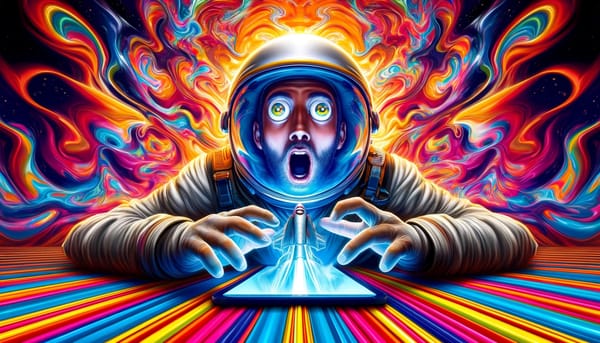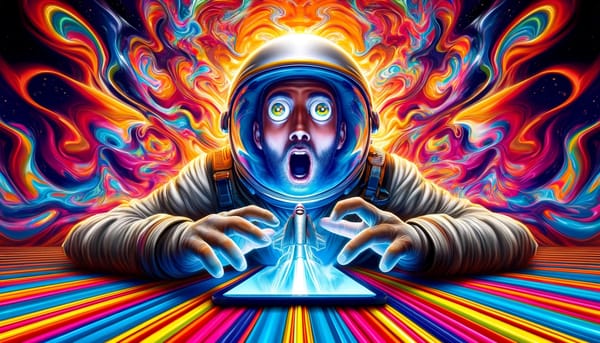AI & the Terror of Power
The tool of our time, and whether (how) to wield it.

I can’t decide whether I’m super into Amazon’s The Rings of Power series or whether I’m annoyed that it’s messing around (IMO) with Tolkien’s legacy. In the ‘pro’ column: Adar, S2 Ep 7 battle scene, the Balrog. In the ‘con’ column: Galadriel, the Celebrimbor arc, and the writing in general.
A central theme of RoP (and Tolkien’s work generally) is the corrupting influence of power. Without integrity, power becomes toxic and turns even the noblest among us into terrifying overlords (see: Saruman).
In both RoP and the Lord of the Rings film trilogy, the namesake rings of power are shown to be tools of vast potential. That potential offers both good and bad outcomes. What determines whether the outcome is good or bad largely depends on what a the ring’s maker infuses into the ring. The rings are tools.
AI is such a tool. And unlike the rings of power, I think even Gandalf would say AI is tool we must wield for positive effect.
Generative AI is transforming the landscape of marketing, and it’s time for marketers to embrace it. I laid out a summary case in the last edition of Hype Cycle for why and how marketers can utilize AI to 10X their output. While AI can obviously streamline administrative work, areas of opportunity exist where work needs not streamlined but supercharged; particularly in territories where strategy and creativity intersect. Rather than think of AI as water cutting the flavor and intensity of a delicious cocktail, think of it as a fine liquer that enriches the flavor.
You can use AI to augment campaigns by providing deeper personalization, accelerating creative processes, and driving engagement with customers in more efficient and innovative ways. As we explore AI’s potential, it’s clear that marketers who successfully blend machine-driven insights with human creativity are gaining a competitive edge. I’ll highlight a few use cases.

The Role of AI in Strategy and Personalization
One of the most powerful uses of AI in marketing is in personalizing customer interactions. AI-driven platforms, like Starbucks’ Deep Brew, use machine learning to analyze data from their loyalty program and app to offer personalized recommendations tailored to each customer’s preferences. Starbucks found that by using this technology, they not only boosted sales but also enhanced customer loyalty and engagement. This level of personalization is now expected across industries and is proven to drive better business results.
Similarly, the telecom industry is using AI to deliver hyper-localized and highly targeted messages. A European telecommunications company used AI to move from generic, one-size-fits-all marketing to messages tailored to 150 distinct customer segments. By customizing messaging based on demographic and regional data, they saw a 40% increase in engagement and reduced costs by 25%. This example highlights how AI can dramatically enhance customer outreach by optimizing both the content and the context in which it’s delivered.
AI Boosting Creative Campaigns
OK, here we go. This is the area of marketing where 🔥 takes are flying fast and furious. “AI is amazing and should be the center of your creative arsenal!” Then on the flisside, “AI is cookie-cutter bullshit that needs to be unplugged!” If everyone could just breathe into a paper bag for a moment, we can get down to business… 😑
AI provides marketers with tools to generate fresh, engaging content at scale that still requires human polish and curation. There’s a balance to be struck: between being able to speed up the idea development process as well as scale an integrated, multi-channel storytelling effort, and the human emotional quotient that needs to be woven into the fabric of concepts. CPG brands are taking the lead here, with some impressive early results.
One example is Coca-Cola’s AI-driven product customization campaign, which allowed customers to design their own unique bottle labels using AI-generated patterns. This campaign not only increased sales but also spurred social media engagement as customers shared their personalized bottles online, creating a viral effect that bolstered brand visibility. It’s a strong example of community-led marketing that allowed the brand to exert more influence in fans’ creative outputs by leveraging AI.
PepsiCo offers another example of AI amplifying creativity. They implemented an AI tool called Adato test creative ideas and gauge audience reactions in real-time. This enabled PepsiCo to produce more relevant ads with shorter turnaround times, which translated into higher returns on ad spend. The brand’s approach to using AI for faster creative development while maintaining high standards of content shows how technology can enhance the creative process, not replace it.
In the luxury automotive industry, BMW harnessed AI to personalize its outdoor advertising with interactive billboards. These AI-powered billboards detected when BMW cars passed by and displayed customized messages tailored to the driver’s preferences. This kind of real-time interaction showcases AI's potential to create hyper-personalized, memorable ad experiences. In fact, BMW is incorporating AI into its business beyond billboards.
Generative AI and Content Creation
The rise of generative AI is also streamlining content creation, allowing marketers to produce everything from social media copy to high-fidelity product concepts in a fraction of the time. For example, an Asian beverage company leveraged generative AI to accelerate the development of new products and marketing materials. What typically would take weeks to conceptualize and design was accomplished in mere days, speeding their time to market.
Unilever provides another compelling case, using AI to handle content creation and even product descriptions on platforms like Amazon. Their custom AI solutions not only generate marketing copy but also analyze sentiment in consumer communications, which has significantly reduced response times and improved customer engagement. These examples highlight how AI can shoulder repetitive creative tasks, leaving marketers free to focus on higher-level strategy and innovation.
Balancing Automation with Human Insight
While AI offers incredible potential, marketers must balance automation with human oversight. AI is highly effective at pattern recognition and data analysis, but it lacks the emotional intelligence and cultural nuance that only humans can provide. This is particularly important because emotional resonance still overrides rational decision-making in a lot of situations.
For example, although Lexus used AI to write and direct a car commercial, human creatives were still involved in ensuring that the final product aligned with the brand's voice and emotional tone. AI can suggest tactical creative directions based on data, but marketers need to refine and humanize those ideas to ensure they connect authentically with consumers. Moreover, marketers must be mindful of AI's limitations. AI-generated content may sometimes produce results that are repetitive or fail to capture the essence of what makes a brand unique. Guardrails are essential to ensure that AI-enhanced marketing efforts are ethical, transparent, and aligned with the brand's goals.
After all, a fool with a tool is still just a fool. The wielder needs the right mindset and fortitude to harness the tool’s power for positive outcomes. Just like Frodo.




